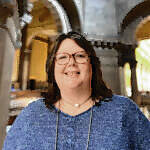Staff and Wire Reports
The internationally acclaimed architect who designed two of Columbus’ notable buildings, Columbus Signature Academy — Lincoln Campus and St. Peter’s Lutheran Church, has died.
Gunnar Birkerts succumbed to congestive heart failure Tuesday at age 92 at his home of Needham, Massachusetts, his son Sven Birkerts said.
The architect’s two Columbus building designs, completed 21 years apart, are across the street from each other.
Innovative school
Columbus Signature Academy — Lincoln Campus, at 750 Fifth St., was completed 50 years ago in 1967, then known as Lincoln Elementary School.
The American Institute of Architects gave the Lincoln school design, reflecting the Modernistic style, an Honor Award in 1970, one of five buildings recognized in Columbus by the architects group.
Lincoln was the first school building in the United States to provide handicapped access to both levels of the school building via ramps and elevator, according to a description by the Columbus Area Visitors Center.
Years before Americans with Disabilities Act requirements, Birkerts’ design for Lincoln featured extra wide doors, an elevator and self-contained classrooms. The building in 1970 also won the Bartlett Award, which recognizes buildings designed for full-time use by the physically challenged.
Also according to the visitors center:
Designing Lincoln gave Birkerts the challenge of building a school for elementary children that was close to downtown along a busy traffic street. The school board wanted a building with a playground area protected from traffic along with green space all on a small, single-square-block site. The board also expressed the desire to keep the scale small out of respect to the mostly residential area that was there at the time.
Birkerts designed Lincoln to fit into its surroundings without drawing undue attention to itself. The building is lowered half a level underground with a sunken court around the exterior. From the street, it visually appears as a one-story building with direct access to both levels.
An aerial view of Lincoln shows it as a square within a circle within a square. The square building is surrounded by a circular concrete retaining wall and a circular ring of Linden trees to give it a park-like quality. It is surrounded again by the square of the city block on which it sits. Some say a bird’s-eye view of the building shows it as a “square peg in a round hole.”
Ricky Berkey, who chronicles the city’s distinctive architecture in a blog, wrote that Lincoln was the first Columbus school to be carpeted and air-conditioned, which some people thought at the time to be extravagent, but the building turned out to be exceptionally energy-efficient.
Berkey wrote that the building saw its first students on April 17, 1967. Ladybird Johnson, wife of President Lyndon Johnson, dedicated a plaque at the entrance to the school four days later during her Crossroads U.S.A. tour, honoring the school and Columbus for its efforts in beautifying America, which was a central theme of her years in the White House.
In her speech, the first lady said: “It is said that architecture is Frozen Music, but seldom in history has such a group of devoted artists produced such a Symphony in Stone as presents itself to the eye in Columbus, Indiana.”
Formal dedication of the school took place on May 28, 1967, with Birkerts present.
“People underestimate how important that was 50 years ago,” said Richard McCoy, director of Landmark Columbus, which works to protect the city’s architectural gems. “His work there really represents the Cummins architectural program emerging in the national spotlight. That really catapulted his career.”
Berkerts may not have been as well known as other high-stature architects whose work is also showcased in Columbus, such as Eero Saarinen or Kevin Roche, “but he was just as prolific,” McCoy said.
Bartholomew Consolidated School Corp. is planning a 50th Anniversary Celebration for Lincoln. The Sept. 21 event will include student-led tours, student project demonstrations and refreshments from noon to 1 p.m., followed immediately by the hour-long anniversary celebration, principal Brett Findley said.
As part of anniversary plans, the visitors center will conduct architectural tours of CSA-Lincoln Elementary on Sept. 16-17, Findley said, with tour tickets available for purchase at the visitors center website, columbus.in.us
Distinctive church
The Modernism design of the church, at 719 Fifth St., completed in 1988, included these notable features:
Duality: Northern exterior is curved red brick, the southern side is flat white concrete.
Minimalism of interior colors and materials.
Asymmetrical — but balanced — interior.
186-foot cooper-clad spire.
Birkerts was widely known for the use of light in his designs.
Architect Gunnar Birkerts, in a 2013 interview The Republic, said the duality serves two primary functions: It follows the design of the church interior, but also reflects the duality of people, the thought that good and evil exist in everyone.
“The intent was to express that in the building itself,” Birkerts said.
The interior, which Birkerts said dictated the exterior design, was a result primarily of lighting considerations.
The northside windows allow views of the outside but let in only diffused light, because the sun never shines through that side directly.
On the south side, meanwhile, Birkerts designed a series of high, parallel walls to create what he calls “fins,” which allow sunlight to enter only after it bounces off the walls but prevent it from beaming directly into the sanctuary and blinding congregants during worship.
The exterior shapes encroach upon the interior, especially the chancel, the interior’s centerpiece, while continuing the duality theme. The left side of the chancel is bordered by a flat wall (one of the fins on the south), while the right side is bordered by a curved wall. Rather than connect that curved wall on the right with the straight wall on the left in the chancel’s center, Birkerts allows the straight wall to continue behind the curved wall, creating a gap between the walls and allowing more indirect light to enter the chancel just behind the cross, which hangs centrally above the altar.
World reputation
Birkerts designed buildings around the world that included the Federal Reserve Bank in Minneapolis, the Corning Museum of Glass in Corning, New York, and the University of Michigan Law Library. Some of his other notable buildings include the Kemper Museum of Contemporary Art in Kansas City, Missouri, the IBM headquarters in Sterling Forest, New York, and the U.S. Embassy in Venezuela.
Birkerts was born in Riga, Latvia, on Jan. 17, 1925, but fled during World War II when he was in his teens. He made his way to Stuttgart, Germany, where he began studying architecture. In 1949, Birkerts emigrated to the United States. He was based in the Detroit area for much of his career and worked for several different architecture firms, including Eero Saarinen and Associates, before Birkerts and a colleague, Frank Straub, founded Birkerts and Straub in 1962.
He eventually went on to lead his own firm, Gunnar Birkerts and Associates, for decades. He also taught architecture at the University of Michigan from 1959-1990.
His final work, the National Library of Latvia in Riga, opened in 2014 and is now widely known as “The Castle of Light.” The American Institute of Architects awarded the library its 2017 Library Building Award.
Birkerts is survived by his wife, Sylvia, a fellow Latvian who he met in Germany and married in 1950, their three children and seven grandchildren.










